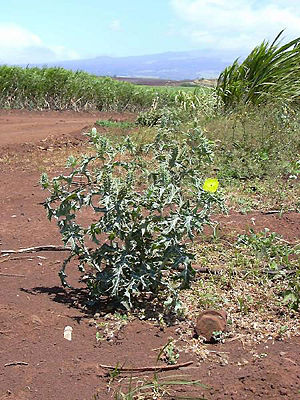- Argemone mexicana
-
Mexikanischer Stachelmohn Systematik Unterklasse: Hahnenfußähnliche (Ranunculidae) Ordnung: Hahnenfußartige (Ranunculales) Familie: Mohngewächse (Papaveraceae) Unterfamilie: Papaveroideae Gattung: Stachelmohn (Argemone) Art: Mexikanischer Stachelmohn Wissenschaftlicher Name Argemone mexicana L. Der Mexikanische Stachelmohn (Argemone mexicana) ist eine Pflanzenart aus der Gattung Stachelmohn (Argemone) in der Familie der Mohngewächse (Papaveraceae) .
Inhaltsverzeichnis
Merkmale
Der Mexikanische Stachelmohn ist eine einjährige Pflanze, die Wuchshöhen von 25 bis 100 Zentimeter erreicht. Die Blätter sind kahl, graugrün, buchtig fiederspaltig, sitzend und mehr oder weniger stängelumfassend. Sie messen 6 bis 20 × 3 bis 8 Zentimeter. An ihrem Rand und auf den Adern befinden sich Stacheln. Die Blüten haben einen Durchmesser von 4 bis 7 Zentimeter. Die Kronblätter sind zitronengelb bis orange gefärbt. Es sind 20 bis 75 Staubblätter vorhanden.
Vorkommen
Der Mexikanische Stachelmohn stammt ursprünglich aus Süd-Florida und der Karibik, wo er auf trockenen Sandflächen vorkommt. Er ist weit eingebürgert in den Suptropen, den südlichen und östlichen USA sowie in Süd- und West-Europa.
Nutzung
Der Mexikanische Stachelmohn wird selten als Zierpflanze in Sommerblumenbeeten genutzt, sowie als Ölpflanze. Er ist seit spätestens 1592 in Kultur.
Belege
- Eckehardt J. Jäger, Friedrich Ebel, Peter Hanelt, Gerd K. Müller (Hrsg.): Rothmaler Exkursionsflora von Deutschland. Band 5: Krautige Zier- und Nutzpflanzen. Spektrum Akademischer Verlag, Berlin Heidelberg 2008, ISBN 978-3-8274-0918-8.
Weblinks
Wikimedia Foundation.

